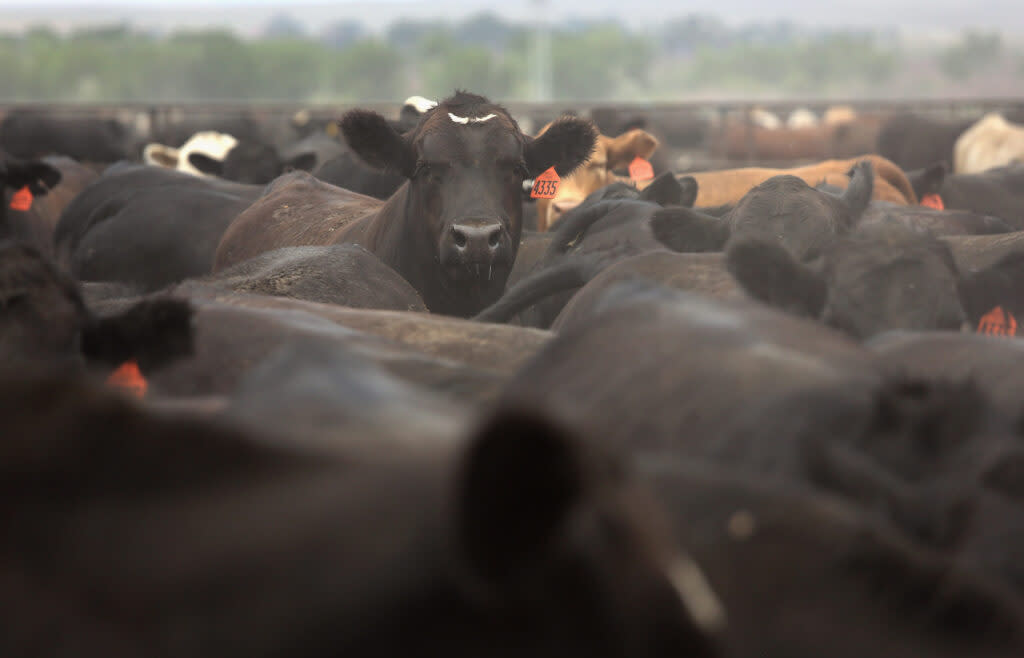Oregon livestock farmers will soon face more oversight

Some of the proposed changes include include stricter water use and construction requirements. (John Moore/Getty Images)
Oregon farmers raising sheep, chicken or cows will soon have to comply with new state rules.
Environmental groups and some small farm advocates say the changes bring much-needed clarification on who qualifies for a permit usually reserved for large, commercial-scale livestock farms, while some agriculture trade groups say the changes put more undue burden on farmers.
The Oregon Department of Agriculture is wrapping up a process that began after some farm and environmental groups lobbied state legislators for more regulatory oversight on large, commercial-scale livestock farms.
The agency is proposing several changes to the state’s confined animal feeding operation, or CAFO, permit program as a result of the Senate Bill 85 reform package signed into law last year by Gov. Tina Kotek. Some of the proposed changes include stricter water use and construction requirements, as well as a clarified definition of a CAFO.
A CAFO permit is a water quality protection permit that outlines protections for sources of water like rivers, creeks, lakes and groundwater from nutrient pollution caused by animal waste.
On water use, livestock farmers will only be able to use up to 12,000 gallons of water per day for animal drinking water. Before, livestock farmers did not have to disclose how much water they were using or where they planned to get it from.
That change comes as some areas across Oregon are dealing with rapid groundwater depletion due to over-pumping, which is causing wells to run dry, and affecting residential communities and irrigated farming operations.
Perhaps a more significant change is a clarified definition of a CAFO. In early 2023, ODA issued a public notice requiring small raw dairy farms to apply for a CAFO permit, even if that farm only had just a handful of cows, which would have been financially burdensome for many small farms. The decision led to public outcry and even a lawsuit against the state from some small raw milk producers. The agency later reversed that decision.
Now, the draft rules define a CAFO as a livestock operation that houses animals in buildings or pens for 12 hours or more per day for more than 120 days per year.
The Oregon Department of Agriculture also established a lower limit threshold on when a small farm needs to apply for a CAFO permit. Before, any farm with fewer than 200 dairy cows, for instance, that met the requirements for a CAFO had to apply for the permit.
“Technically every farm in the state could have been asked to get a CAFO permit if they had any animals on site,” said Alice Morrison, co-director at the nonprofit Friends of Family Farmers. “We don’t need to apply a standard that was designed for a certain type of farm to literally every farm in Oregon.”
The new clarification means farmers with fewer than 20 dairy cows, or fewer than 250 laying hens will not be required to get a CAFO permit unless they produce over 100 gallons of water water or manure per day.
Morrison said she sees the clarification as a significant win for small, diversified livestock farmers.
Other groups, like the Oregon Farm Bureau, the Oregon Dairy Farmers Association and the Northwest Chicken Council view more regulation as an unneeded burden on the industry and local food supply chain.
Bill Mattos, president of the Northwest Chicken Council, said the changes will just saddle producers with more paperwork and requirements.
“The challenging environment for agriculture and the pressure from urban growth, lack of land availability and advocacy groups who oppose animal agriculture are all creating greater risks to our local food supply,” he said. “However, we think that the changes to the proposed SB 85 rules are largely in line with the authority granted in SB 85 and the legislative intent.”
The state Department of Agriculture is asking people to weigh in on the changes to the CAFO program. Public written comments are due by July 22. The agency will likely adopt the changes later this summer.
This story was originally published by Oregon Public Broadcasting, a Capital Chronicle news partner.
The post Oregon livestock farmers will soon face more oversight appeared first on Oregon Capital Chronicle.

